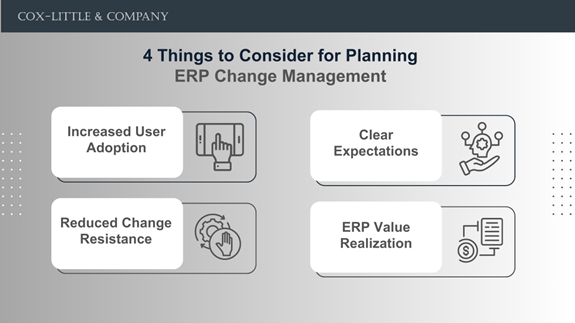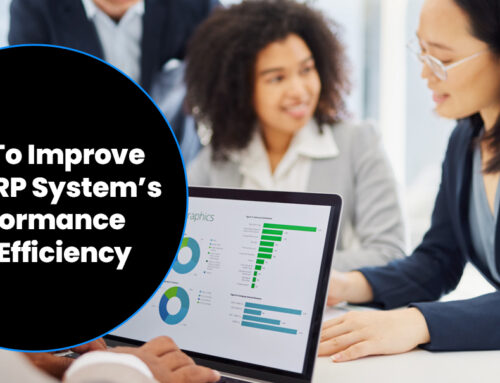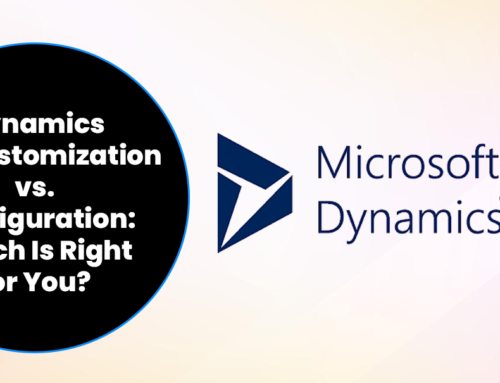
Every business is aware of the enduring power of change but is hardwired to expect predictability and stability. The same applies to choosing, implementing, and managing a new ERP system across an organization. No matter how unique and impactful ERP software could be, only an effective ERP change management strategy makes it easier for a smooth transition with minimal disruption.
As per the research data based on years of ERP implementations, almost 50% of the ERP projects fail the first time. The cost of ERP implementation increases three to four times the actual budget and takes 30% more time than expected. Research by Mint Jutras, a leading ERP analyst company, also recognizes change management as one of the key success metrics for ERP implementation.
In the dynamic realm of rapid digitization, cloud computing, AI (Artificial Intelligence), ML (Machine Learning), and other emerging technology integrations with ERP platforms, change management strategies are the real assurance against people-led ERP implementation failures!
This article will delve into the essentials of change management as a concept and change management strategies for ERP implementation. We will also explore our expert guidelines for establishing a well-curated ERP management plan for a smooth and successful implementation.
What Does Change Management Mean?
According to the Harvard Business School, change management is an ‘organizational change,’ referring to business actions to change or adjustment of significant components of an organization. This includes company culture, internal processes, and workflow, underlying tech or infrastructure change, or any other critical aspect.
The Association of Change Management Professionals defines change management as the practice of applying a structure transition approach to an organization from the current to a future state to achieve desired benefits.
Several thought leaders pioneered change management as an organizational behavior, underpinning it as an individual emotional and psychological response to change. But, as a formal discipline, change management has been around since the 1990s. It became a global topic with bestsellers like ‘Leading Change’ by John Kotter and ‘Who Moved My Cheese’ by Spencer Johnson. The U.S. multi-conglomerate General Electric or GE’s successful change initiative is a historic use case for change management. GE managed to cope with the pressures of the booming tech and globalization trends of the 90s, revitalizing financial performance and bringing in a radical cultural shift with a change strategy.
Change management evolved dynamically with times and technology disruptions, finding relevance as a formal practice and concept in business areas like project and IT infrastructure management and software development. Several change management models also emerged to help businesses match their change initiatives using their available tools and resources in the organization. The most prevalent change management models include Jeff Hiatt’s five sequential ADKAR model (awareness, desire, knowledge, ability, and reinforcement), Bridges’ Transition Model, John Kotter’s Eight Steps, McKinsey’s 7-S, and more.
What is ERP Change Management?
ERP change management is about easing the people side of the transition with appropriate measures to ensure they adapt and embrace the new ERP software platform well.
Globally, organizations across industries invest significant amounts in change management projects and hire change management professionals or analysts to navigate the overwhelming scale of transition. For ERP solution adoption, in-house or external ERP project teams of consultants, experts, or change management professionals work with internal project teams to devise a comprehensive change plan. The experience, certifications, and insights of change management professionals are necessary to strategize a way to mitigate the risk of sudden disruption and increased cost and time of implementation. When combined with the industry experience and knowledge of ERP professionals, a firm can confidently strive for innovation, improve stakeholder engagement, and maximize value generation from adopting ERP software.
Internal teams can champion ERP implementation using Agile, Scrum, or traditional project management methodology. Irrespective of the implementation method, change can be achieved when the change objectives are well-detailed and aptly articulated to the staff and departments. ERP change management plan starts with a thorough assessment of the organization’s readiness to change with tests, surveys, and interviews to gauge and communicate the stakeholders’ realistic attitudes towards the transitions. The change management plan also involves analyzing stakeholders’ engagements, from C-suite leaders to department managers to end-users, planning and providing relevant ERP training programs, and addressing feedback on ERP usage and other concerns.
There is no linear path to ERP change management. Even though standard change management models like ADKARA are applicable for ERP implementation, it is better to operate with the belief that every organization is unique. The barriers to change vary, and so does the stakeholder or end-user interpretation of the context of change accompanying ERP implementation. Therefore, it is recommended to consider below four objectives below for planning ERP change management:

- Increased User Adoption: Poor adoption rate defeats the purpose of ERP implementation. ERP change management is tied to actively involving employees or all relevant stakeholders in the change process to make them more acquainted with the platform’s capabilities for higher user adoption and increased ERP platform utilization.
- Reduced Change Resistance: Initial resistance to process or software platform change is a common hiccup that every organization needs to fix by identifying potential causes for resistance. Neither the firm nor its end-users want ERP software with a steep learning curve or complex patterns of usage or operations that require more resources and time utilization to transition into the new ERP environment. Change management plan also considers building strategies that catch and remediate causes of user resistance.
- Clear Expectations: The ERP software implementation process and the outcome of the software investment at both organizational and individual user levels must be communicated with accurate and realistic data. Managing stakeholder expectations and setting clear guidelines about ERP platform implementation will help foster trust among the stakeholders and build their readiness to cooperate and contribute during uncertainties or risks.
- ERP Value Realization: ERP users know the ERP software benefits to their organization like centralized processes, better and secure data accessibility, no more siloed structures, higher stakeholder and systems collaboration, and enhanced decision making. ERP change management plan outlines the benefits and functionalities of the ERP software platform to empower users with the required skills, training, and knowledge to leverage the system for maximum value realization.
We are already aware of the latest advancements in ERP and the incremental ways it impacts businesses across industries. Implementing ERP change management strategies that are built to facilitate businesses and enterprises to reach the desired state of organizational agility and operational productivity by leveraging innovative ERP software platforms is vital. Our ERP experts recommend formulating change management strategies with the guidelines below:
Expert Guidelines for Building an Effective ERP Change Management Strategy
- Visualize the Change: A clear change plan is essential for the organization, its leaders, and end users. It requires visualizing the desired change with KPIs and goals so that it can be justified for choosing an ERP platform, its implementation, customization, and other configurations. It should be actively communicated with the rest of the organization.
- Proactive Communication: ERP change management is action-oriented and requires a good word of mouth within the organization. A significant part of the ERP change management effort is in documenting change initiatives and actively communicating with teams and individuals in a format relevant to their roles and functions. Updates about change status also help leaders, IT decision makers, developers, and project managers plan for resources, training, and support initiatives.
- Build a Compelling Change Management Team: We are already aware that change management as a process requires dedicated resources with the right skills and capabilities. Rather than taking a wild guess, teams, and departments can seek guidance and suggestions from teams that are well-versed in handling and driving ERP change management projects or have a deep understanding of ERP implementation projects. A strong change management team that is exclusively focused on ERP implementation guarantees higher success rates and reduced burnout levels for internal IT staff.
- Elevate Employee Experience: The target areas for change management in 2024 would be employee engagement and empowerment. According to a survey on Employee Engagement trends in the U.S., almost one-third of the employees in organizations need help understanding the reasons for change. In the larger sense, this would create several roadblocks to innovations and change expansion projects. Firms that invest in empowering employees to embrace change with tools and training regarding the post-implementation phase, system updates, maintenance, security, and vendor support can experience better support and coordination by teams. Additionally, they can leverage their feedback and insights to enhance the transition to a new ERP ecosystem.
- Make Change Management More Data-driven: According to a recent study by Capgemini on change management, almost 61% of businesses rely on data analytics for decision-making. Using data-driven approaches in change management is not fully exploited and can serve as an excellent value add. The use of data analytics cushions teams and change analysts against risks. It also helps extrapolate trends in the future to weigh in on change measures. However, this entirely depends on the level of data maturity of organizations. Firms of every size in today’s age can optimize data mining, analytics, and AI-led tools for data-driven, ERP change management decisions.
- Track and Audit Change: Proactive tracking of change initiatives and feedback from ERP platform users help understand loopholes in ERP projects. It helps identify areas to be optimized for maximum value creation. ERP change management is a continuous and iterative process. Tracking progress and auditing the impact of change initiatives are needed for success benchmarking, scalability planning, user training, and refining change elements.
- Commemorate Successful ERP Roll-out: ERP software implementation is no walk in the park. Achieving a seamless transition to the new ERP environment results from the combined efforts and contributions of stakeholders and employees within an organization. Rewarding the change and attitude towards change impacts ERP adoption rates, organizational resilience, operational productivity, and employee morale.
Our Takeaway: People Make ERP Change Management Worthwhile
Ask any leader what scares them the most about change management. The answers may subjectively vary. But, embracing change and letting go of the known is enough to keep a CIO and CTO awake at night. A takeaway from GE’s change management lesson that is relevant even today is not dismissing the role of employees or people resources. In ERP change management, innovation depends on the people’s (users or employees) conviction to welcome and embrace it.
ERP implementation in today’s digital world is more than the selection of a software vendor and skills to help plug and play software. ERP journeys are deliberately slow but continuous. They represent impactful shifts that a highly integrated software platform can bring into an organization across the financial, human resources, supply chain, distribution, sales, customer relationship management, manufacturing, transportation, warehousing, and other domains. ERP change management is an opportunity to streamline efforts, workflows, talent, and insights towards quantifiable ERP rollouts.
The unencouraging reality of assembling a team of diverse, experienced, and pre-vetted ERP and ERP change management experts leads to a severe talent gap within organizations. At COX-LITTLE & COMPANY, we have successfully addressed ERP talent shortage for customers across industries through our ERP staffing solutions and resources. Our consultants know the demands of current technology and the industrial climate. We believe additional ERP staffing can empower businesses and their internal IT teams to build strong change management practices by bringing together the capabilities of people, processes, and ERP systems.
Let us discuss how ERP change management can be a transformative opportunity with the right talent at the right time! Contact us now.





